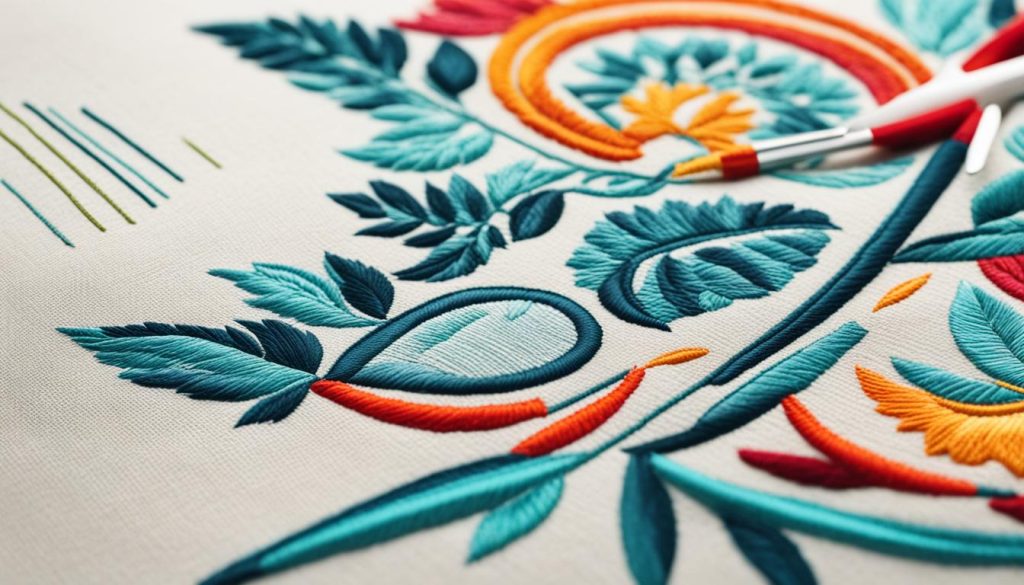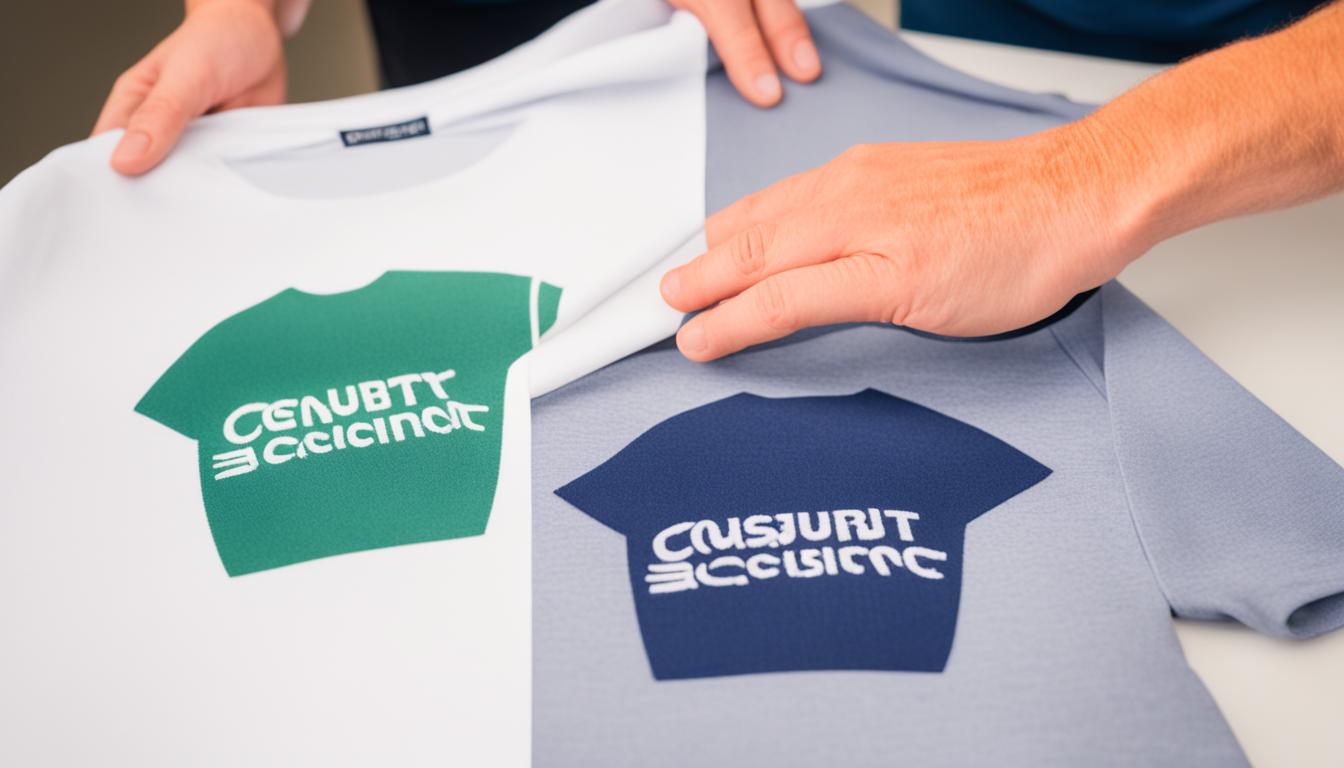Ever thought about which is better over time, embroidery or screen printing? They’re both common for adding logos or designs on clothes. But, embroidery stands out for making designs with thread, and screen printing uses ink and screens. Knowing what each method offers helps in choosing the right one for your needs.
Embroidery is often linked with better quality and is perfect for business wear like shirts, caps, and jackets. This method creates strong and detailed designs. It’s good because machines can work on many items at once with lots of colors.
Screen printing, on the other hand, shines when it comes to softer materials like t-shirts. It’s great for big batches since it’s more affordable. You get colorful and detailed designs with this method. It’s slower than embroidery but better for those soft, thin clothes.
Key Takeaways
- Embroidery tends to last longer than screen printing, often outliving the garment itself.
- The durability of embroidery makes it ideal for thicker garments like polos and fleece, where it retains its structure and color.
- Screen printing is more versatile for large, colorful designs, especially on soft, stretchy fabrics.
- For smaller quantities and multi-color designs, embroidery can be more cost-effective due to set pricing.
- Both techniques have specific care instructions to prolong their lifespan, such as washing inside out and air-drying.
Understanding the Process: Embroidery vs. Screen Printing
Embroidery and screen printing customize clothing in different ways. They both have strong points. If you want detailed designs, embroidery might be best. For vibrant, detailed prints, go for screen printing.
What is Embroidery?
Embroidery is stitching your design onto fabric with thread. You can use up to 15 colors in one design. It’s great for soft, thick fabrics like cotton and denim.

What is Screen Printing?
Screen printing uses screens and ink to print designs. It’s good for t-shirts and big orders. This method is best for lighter fabrics.
Comparing Techniques
Embroidery and screen printing both have their places. Here’s how they stack up:
| Factor | Embroidery | Screen Printing |
|---|---|---|
| Detail | Best for heavier, durable designs; often used for logos | Captures fine details and gradients; ideal for large, intricate designs |
| Fabric Compatibility | Heavier fabrics like woven cotton, denim | Lighter fabrics such as rayon, cotton, cotton-polyester blends |
| Cost | Slightly higher, but the decoration lasts longer than the garment | Lower cost, but the garment lasts longer than the decoration |
| Order Size | Not dependent on order size | More cost-effective for larger orders; influenced by the number of colors |
| Setup | Requires digitizing the design | Requires creating screens for each color |
Choose the method that fits your clothing use. Do you need clothing for work, events, or daily wear? Consider the fabric type and design complexity.
Durability and Longevity
Embroidery and screen print techniques vary in durability and longevity. The threading process is key in determining how well each method stands the test of time. We will look at how these methods hold up against washing and everyday wear.
Factors Affecting Durability
High-quality embroidery, done with strong polyester threads, lasts a long time. This makes it a top choice for workwear and heavily used textiles. However, silk threads, while pretty, don’t last as long. They might only look good for up to two years.
Screen printing, on the other hand, may not last as long because the ink can come off. This is especially true for harshly used or frequently washed items. Yet, screen printing does offer more design options.
The Impact of Washing and Wear
Proper care is vital for keeping embroidery and screen printing looking good. Machine embroidery usually holds up better than screen printing after washes. The right washing method can make a huge difference for embroidery’s lifespan.

Screen prints can wear out faster, with the ink becoming damaged over time. Even so, some prefer their shiny look. Choosing between looks and longevity is a big part of this decision.
Hand embroidery can take a while, but it leads to one-of-a-kind designs. It is growing in popularity for looking professional on various fabrics. Taking care of your clothes, by washing them right and storing them well, can make them last longer.
Embroidery for High-Quality and Professional Appearances
High-quality embroidery boosts your brand’s professional image like nothing else. It’s known for being tough, able to last through washes. This means your logo on shirts, jackets, or bags will stand strong over time.
Professional embroidery screams experience and authority, especially on uniforms. So, choose it for that quality look.

Modern embroidery is adaptable. It suits many items, from polo shirts to duffel bags. This means you can keep your look consistent no matter the item. The results are sleek and perfect for any business setting.
Embroidery lasts longer than most printing. This means your logo on hats or outerwear will be seen for a while. They’re memorable as gifts or at events.
- Embroidered polo shirts: Perfect for company wear
- Embroidered hats: Great for branding without size worries
- Embroidered bags: Visible and versatile for both genders
Embroidery hoop art is also catching on. Even newcomers can create something stunning with embroidery. Making just six custom pieces is super easy. You can pick from various fabrics for the perfect look.
There are many thread types for embroidery, from metallic to matte. They all match Pantone colors to keep your brand true. Plus, special techniques like applique make your logo pop.
In short, embroidery is a smart choice for your branding. It’s reliable, making outfits or team logos look amazing. Whether you’re just starting or a pro, the goodness of professional embroidery stands out.
Cost-Effectiveness: Embroidery vs. Screen Printing
When we look at embroidery versus screen printing, we see they differ in costs. It’s important to note the setup costs and how much you pay over time. The type of clothing also plays a big role in the final price.
Initial Setup Costs
Each method, embroidery and screen printing, has its own setup costs. Embroidery costs more at the start because of digitizing. This step turns your design into one that can be stitched. But, after this, adding more colors doesn’t raise the price much. Screen printing affordability is great for large orders. As you print more, the cost per item becomes lower. Printing requires a screen for each color, which adds up fast.
Cost-Per-Wear Analysis
Doing a cost-per-wear check shows how valuable each method is. Embroidery lasts a long time and looks high-end, making its cost worth it. Over the years, screen prints can wear out from washing and use, lowering their value.
For things you use a lot, embroidery can be a better deal.
Garment Type and Price
The fabric and use of the clothing affect the final cost. Embroidery is best for hardy items or professional looks. For lighter clothes like t-shirts or casual wear, screen printing’s vibrant designs work well. Think about the item’s purpose when choosing how to customize it.
| Aspect | Embroidery Cost | Screen Printing Affordability |
|---|---|---|
| Initial Setup Costs | Higher due to digitization fees | Lower, increases with each color |
| Durability | High, long-term value | Prone to crack or fade over time |
| Suitable Garments | Heavy-duty, corporate wear, accessories | Light garments, casual wear, sportswear |
| Cost-Per-Wear | More cost-effective if used frequently | Less durable, might need replacement |
The Versatility of Embroidery and Screen Printing
Embroidery and screen printing are both great for different reasons. They each have unique benefits. Knowing what they are good for helps in picking the best option for you.
Material Compatibility
Embroidery works well on tough fabrics like denim and canvas. It’s perfect for making long-lasting designs on jackets and bags. Screen printing is better for lots of fabric types, from T-shirts to waterproof materials used in safety clothes.
Embroidered items often last longer than printed ones. They can resist damage better. But, embroidery can struggle with very detailed or colorful designs. Screen printing is great for detailed and colorful images, on a wide range of materials.
Design Flexibility
People and small businesses like DIY embroidery for its unique touch. There’s a lot of free patterns available. But, making color changes by hand limits what you can do.
Screen printing, on the other hand, can do big, colorful designs easily. It’s good for making a lot of items at once. This is especially economic for big orders or if you need many designs. While colorful screen prints might be more expensive upfront, they’re a great choice for bulk orders.
Both methods have their own design strengths. They can meet many different design needs. Whether you like the look of raised threads or bold, smooth prints, both have something special to offer.
Conclusion
Choosing between embroidery and screen printing depends on key factors. These include the type of garment, how it will be used, what look you prefer, how long you want it to last, and your budget. Embroidery is praised for its timeless look and lasting quality, making it great for professional and long-lasting wear. The technique has seen a recent rise in popularity, as seen with the #handembroidery hashtag on Instagram.
This method includes various styles like Crewel and Goldwork, making it adaptable and current. It provides a rich feel, with machine embroidery supporting the art of hand stitching. Even The Financial Times calls embroidery “sew hot right now,” highlighting its lasting charm. This craft supports sustainability and the slow fashion movement. Plus, with tutorials on sites like Craftsy and Udemy, it’s easy for anyone to learn and enjoy.
On the flip side, screen printing is great for detailed and custom designs. It’s a top choice for short-term wear or promotional items. This method finds a good balance between being budget-friendly and visually striking, particularly for big orders. Yet, when you really need something to last or for details to pop, embroidery beats screen printing. It adds a special texture and quality to everything from logos on clothes to creative fabric designs.
So, whether you’re into hand embroidery classes or looking into different stitch types, knowing about each technique is crucial. It helps you choose wisely for your specific project needs and goals.
